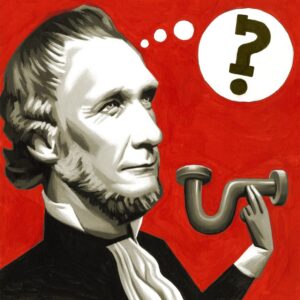We are always a discovery away from rewriting ancient history.
March 21, 2024
In January, scientists announced the discovery of the oldest pre-Columbian cities in the Amazon. They were built in the Upano Valley in Ecuador by an organized urban society that flourished between 800 B.C. and 600 A.D. Surprisingly, this lost Amazonian civilization created cities that resemble modern suburbs, complete with low-density housing, ample green space and manicured road networks. It would seem that ancient urban complexity didn’t just arise in the familiar model of the Eurasian walled city.

ILLUSTRATION: THOMAS FUCHS
This kind of challenge to the scholarly consensus is actually fairly common with the discovery of lost cities. When civilizations are erased from history, bringing them back into the narrative can lead to a dramatic realignment of facts.
The discovery of Troy is an early example of this phenomenon. In 1870, after 12 years of fruitless searching, a German businessman and amateur archaeologist named Heinrich Schliemann found Troy’s ruins near modern Hisarlik on the Turkish Aegean coast. His careless excavation of the site makes modern archaeologists cringe, but against incredible odds Schliemann proved that Homer’s Iliad was based on real events. The study of ancient Greece was changed forever.
Three major discoveries in the early 1900s also reshaped our understanding of the Bronze Age. In 1906, German archaeologists digging through the ruins of a windswept plateau in north-central Turkey uncovered the forgotten city of Hattusa. Its royal archive confirmed that the city had been the last capital of the Hittites and the nerve center of a powerful empire that rivaled Egypt. After a glorious run of five hundred years, the Hittite civilization disintegrated so completely by around 1200 B.C. that little was known about it beyond the mentions in the Bible. The recovery of Hattusa redrew the map of the ancient world, this time with the Hittites at the center.
Across the Aegean, Sir Arthur Evans similarly rescued the Minoans with his discovery around 1905 of the Palace of Knossos on Crete, which flourished between 1700 and 1500 B.C. Evans’s breakthrough was to show that Minoan culture was nonviolent, unlike the other ancient Greek societies known at the time. It was also perhaps matriarchal. The palace, which lacked fortifications, had frescoes of women in authoritative poses. Recovered sculptures often featured goddesses. Evans ultimately argued that Knossos was proof that gender inequality was not, as generally believed, intrinsic to civilization.
The discovery in 1911 of Mohenjo-daro in present-day Pakistan was no less revelatory. This once-vital center of the Indus Valley Civilization, a trading society that thrived between 2500 and 1700 B.C., notably lacked temples, palaces, noble houses or even rich or poor neighborhoods. The city seems to have spent its wealth instead on civic amenities, such as public granaries and universal plumbing.
The egalitarianism at the heart of Mohenjo-daro suggests that the more cities and civilizations we find, the more it will complicate our understanding of human society’s origins. It is humbling to know that we are always a discovery away from rewriting ancient history. It’s invigorating, too.






